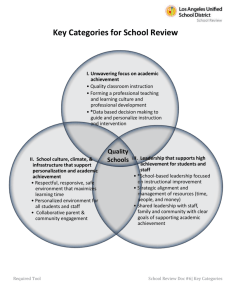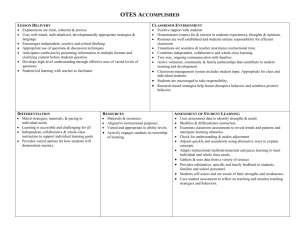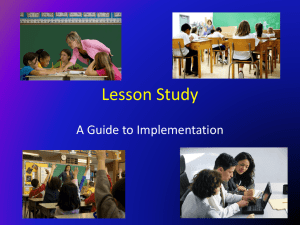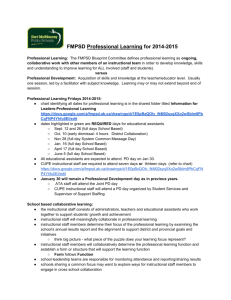Consultation, Collaboration, and Teamwork for Students with
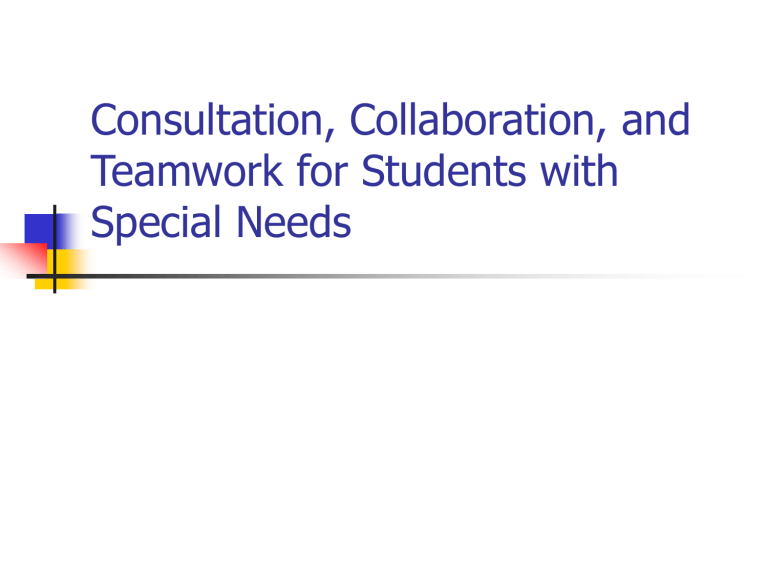
Consultation, Collaboration, and
Teamwork for Students with
Special Needs
Purpose of Instruction
Provide a foundation to construct a practical framework for implementing a collaborative, consultative, or teamwork approach to meeting the needs of all students in your school.
Historical Perspective
Teachers are use to functioning autonomously in their classrooms. In the past asking for assistance often would be viewed as incompetence.
Collegiality
Teachers need structure, training, practice and feedback on how to work together in a collegial manner for the good of all students. Education needs to develop a collaboration ethic.
Appropriate Education PERIOD
We need to talk about the educational needs of the students PERIOD.
We need to stop talking “special education” vs. “general education”
“Special Education” automatically sets the tone for lower expectations.
Collaboration/Consultation
Sharing of expertise
Do not claim to be the experts
Listen well
Learn from others
Help individuals, schools recognize their own skills
Help students achieve highest levels of success and independence
Collaborators
Confer
Contribute
Instruction is enhanced by diversity of values, experience, abilities, and interests.
Seek win/win solutions
Needs of students come before the needs of the adults.
Obstacles for Successful
Collaboration
Resistance from administrators
Resistance from colleagues
Resistance from parents.
Crucial Elements of Effective
Collaboration Services
Communication
Cooperation
Coordination
5 Factors of Successful Inclusive
Schools
#1
Visionary Leadership
positive view towards students with disabilities
positive view regarding the abilities of teachers and families.
Instructional emphasis: ALL staff are responsible for ALL students.
Educators share responsibility for achievement and behavior.
Emphasis on community of learners, high standards, role flexibility, and flexible learning environments.
#2 Collaboration
Teachers are encouraged to collaborate on all levels for all issues. Collaboration among teachers is common. True team work is in existence between grades and levels.
#3 Refocused Use of Assessment
Use more authentic assessment measures or outcomes-based education (OBE)
Use assessment data to drive instruction
Curriculum-based Assessment
portfolio assessments
teacher-made tests
Criterion referenced tests
Curriculum-based measurement
#4 Supports for Students and
Staff
Systematic staff development (annual planning)
Flexible planning time for special educators and general educators
Special Resources are used efficiently across programs
instructional assistants curriculum adaptation integrated therapy services peer supports technology assistive devices
#5 Effective parental involvement
Parents are welcomed, respected, and integral to the school
KDE Collaborative Model
Daily interaction between general and strategic teachers as well as administrators from the school and district level, parents, and related service personnel.
Strategic Teachers
Skilled training in one or more specialized areas
(e.g. behavior management, social skills, speech therapy, giftedness) who use those skills to assist in the development and implementation of instructional strategies.
Characteristics of Collaborative
Schools
Mutual trust
Open communication
Joint effort in problem solving
Pooling of personnel resources
Shared responsibilities in the selection, implementation and evaluation of instructional strategies.
Each member provides expertise
Each member participates in the implementation of preventive strategies and or problem resolutions.
Appropriate Activities for a
Collaborative Teacher
Consult with regular, gifted, vocational, special education, special area teachers, administrators, support services and parents.
Collect formative/summative data on instructional programming to solve problems or identify problems.
Maintain on going progress data.
Modify instructional strategies
Model teaching strategies and assist with transitioning of skills from class to class.
Coordinate and support students transitioning from class to class.
Modify and/or adapt curriculum, materials, strategies, or environmental settings.
Deliver instruction.
Grade/write instructional plans
Collaborative Arrangements
Dyads: 2 teachers work together with on grade level or in one content area
Content Teams:SPED works with teachers in one content area
Grade Level Teams: special education teacher is teamed with one grade level and works on instructional planning
Split Level Teams: SPED teacher works with 2 grade levels or across multiple content areas.
Multiple Collaborative
Arrangements
Student needs first
Staffing needs/team needs
Flexibility in planning and delivery
Different assignments or lessons may require different types of collaboration
Administrator Responsibilities
Resources
Support
Flexible planning time
Priority status for classes/student schedules
Joint planning time
Open communication
Role of the Special Educator
Primary role is to be responsible for the services that are indicated on each student’s IEP. It is the special education teachers responsibility to ensure that students with disabilities are receiving the specially designed instruction and related services as prescribed on their
IEP.
Role of the General Education
Teacher
The general education teacher remains the lead teacher for the content of the course. She/he provides direction for instruction and content emphasis.
She/he works with the special education teacher to plan how they will develop, implement, deliver and assess the core content to the students.
Critical Factors for Success
Flexibility
Scheduling, teaching, methodologies, grading and instructional time
Training
Conflict resolution, effective problem solving
Time
Common Planning time
Schedule
Priority for classes, students, itinerant staff
Support
Administrator, teachers, central office
Planning & Problem
Solving
Agenda
Minutes
Consensus
Resources
Personnel, materials, professional development
